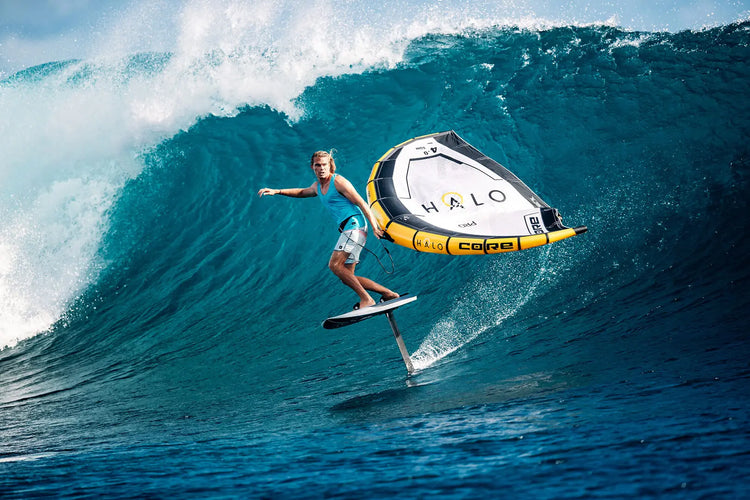Wing foiling, also known as winging or wing foil, is revolutionizing the water sports world by combining the freedom of surfing, the flight of kiteboarding, and the portability of stand-up paddleboarding into one exhilarating package. This guide will explore why wing foiling has become the fastest-growing water sport and why enthusiasts can't stop raving about it.
What Is Wing Foiling? A bit of history
Wing foiling combines a hand-held inflatable wing with a hydrofoil board. The rider stands on a board that has a foil (an underwater wing) mounted on it instead of a traditional fin while holding a lightweight wing in their hands. As the wing in your hands catches the wind, it generates speed which converts to lift on the foil lifting the board above the water, creating a sensation of flying over the surface.
The roots of winging trace back to 1981 when windsurfing inventor Jim Drake and Uli Stanciu created the first rigid spar wing, though it didn't catch on due to traditional boards' high friction. The modern era began in 2011 with Tony Logosz of Slingshot Kiteboarding developing the first "Slingwing" prototypes, followed by Alex Aguera's revolutionary hydrofoil designs in 2016.The sport truly emerged in 2018 when former world champion kitesurfer Marcus "Flash" Austin combined SUP foiling with winging on Maui, using small wings made from old Naish kites. This experiment led to commercial development, with Ken Winner creating inflatable wings for Duotone in spring 2019, marking the beginning of wing foiling's mainstream appeal.
Why Winging Is Awesome - 5 Reasons
1. Easy to Learn
Unlike kiteboarding or windsurfing, wing foiling has a gentler learning curve. The wing is not attached to the board, giving riders more control and making it easier to recover from falls. Unlike a windsurf sail, the wing is light, so there is no back breaking uphauling. Most beginners can get up and ride within a few sessions, especially if they have prior windsurfing knowledge.
2. Incredible Versatility
Wing foiling adapts to various conditions and disciplines:
- Light wind performance (as light as 8 knots!)
- Ocean Waves and flat water
- Different disciplines like freeride cruising, jumping, or surfing
3. Portable and Convenient
One of wing foiling's biggest advantages is its compact setup:
- Wings deflate to backpack size
- Boards are short and compact
- No complicated rigging, just inflate
- Quick setup time (5-10 minutes)
- No need for long lines or large sails and fine tuning
- No need for massive set up space like kiteboarding
4. The Flying Sensation
The most addictive aspect of winging is the unique feeling of:
- Gliding silently above the water
- Smooth, friction-free movement
- Going upwind at ridiculous angles
- Extended ride times with minimal energy
5. Freedom of Movement
Wing foiling offers unmatched freedom:
- No harness required but optional
- Turn around on a dime
- Rig anywhere, you only need about 10 feet of space!
Getting Started with Wing Foil
Essential Gear
- Wing size 4-6m² for most riders (Full discussion about perfect wing size for beginners in this blog!)
- Foil board and can be hard or inflatable
- Pump(regular or electric)
- Hydrofoil
- Wetsuit
- Impact Vest
- Helmet
Best Conditions for Learning
- Wind: 13-20 knots
- Flat water
- Deep water without obstacles
- Professional instruction
The Future of Wing Foiling
The sport continues to evolve, modern wing foiling equipment has come a long way, making the sport more approachable for beginners than ever. New lighter weight materials also make learning a breeze and increase performance tenfold. Moreover, hydrofoils are getting faster with higher aspect designs. People of all ages can enjoy this new exciting sport. I have taught people at 73 years of age and at 7 years of age. Join the fun! Check out our packages here !

